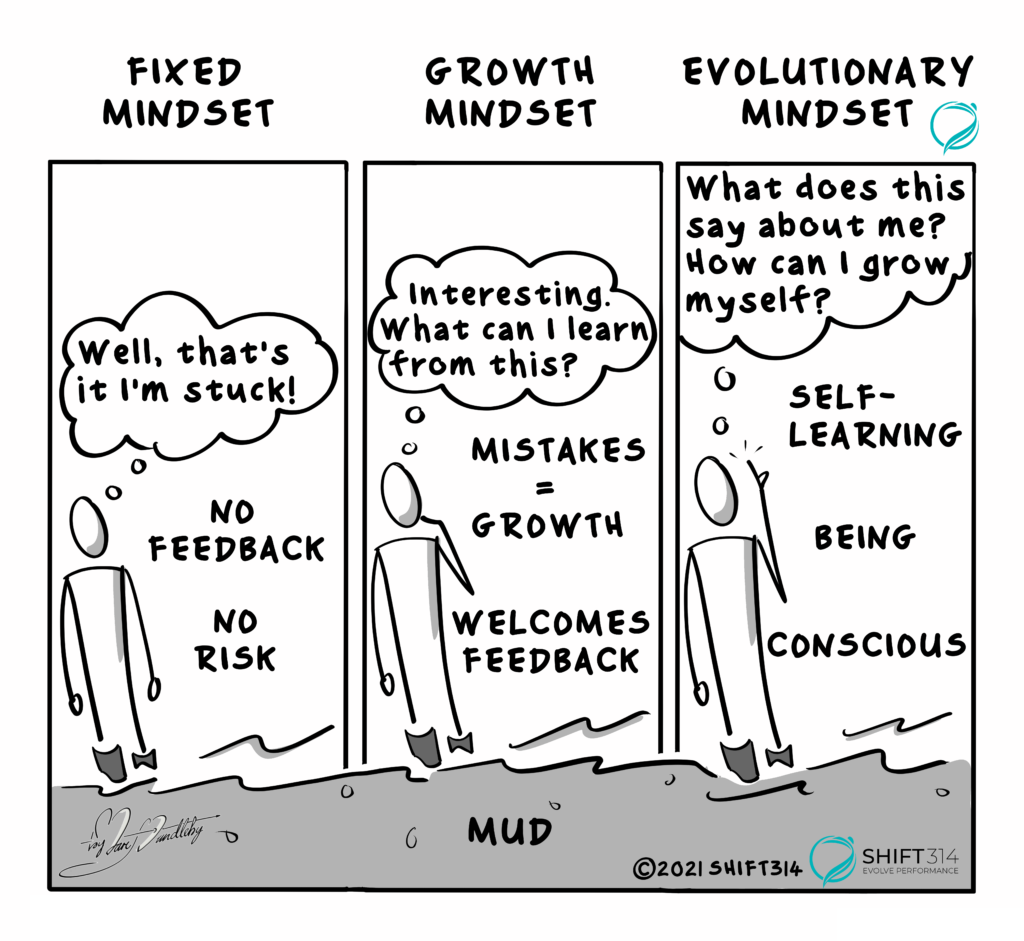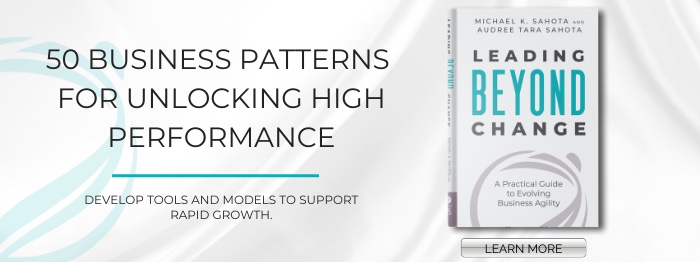The growth mindset is a powerful concept, but it’s not enough. The next step is the Evolutionary Mindset, which includes everything needed to actually create a high-performance organization. The Evolutionary Mindset is the key to organizational success.
Let’s start with the past, the Growth Mindset
What is the Growth Mindset? Carol Dweck coined the term, “growth mindset,” which is differentiated from a “fixed mindset.” In a fixed mindset, we’re not ready to grow or learn – we’re stuck in the way things are right now. In contrast, the Growth Mindset is where one is open to improving themselves.

People who have a growth mindset are interested in learning. They’re interested in finding ways of working better together as a team, creating new products, discovering new ideas, and developing better ways of functioning in the workplace. When they run into a problem, they’re really ready to roll up their sleeves. Instead of blaming others (which is what we do in the fixed mindset) they look and say, “Oh, what can I learn from this?”
An organization where people are in a fixed mindset is in a state of non-change. That means it is actually heading towards being irrelevant and becoming extinct because the world around us is changing.
A Growth Mindset Only Gets You Halfway
The growth mindset is a very powerful concept, and it’s a key indicator that you have what’s needed in yourself to move towards success. If people in your organization have developed a growth mindset, you’re probably already seeing improved performance. But the growth mindset alone isn’t enough.

The growth mindset will get you halfway there. The next question is: are you ready to accelerate your journey? Are you open to investigating how your behavior impacts others? Are you interested to know how you are showing up as a human being? Are you ready to create an extraordinary jump in improving how you can achieve success?
Evolutionary Mindset
What’s missing is what we call an Evolutionary Mindset. An Evolutionary Mindset means not just saying yes to learning and growing – it means asking, what can I do in the external world? – and saying yes to learning about yourself as a human being.
Where am I creating problems through my behaviors? Where are my emotional states creating disturbances for other people? Is it possible that I am the problem? How am I not stepping up and taking full responsibility for my behavior? These are some examples of hard questions people with an Evolutionary Mindset ask themselves.

In our version of high-performance (also known as “teal”) environments, people show up and act like adults. In order for us to act like an adult, we must be ready to introspect. We’re ready to look at how we’re showing up in all aspects of life and invest in making changes.
That’s what we call an Evolutionary Mindset. A growth mindset is the basic starting condition for success and growth. It lets us know that we’re ready to learn about the world around us. An Evolutionary Mindset takes us beyond a growth mindset. Having an Evolutionary Mindset means that we’re ready to look inward, to evolve ourselves as a person, and do the hard work that it takes to be a true leader or contributor.
This is a very simple but powerful concept. When you have a whole organization filled with people who are ready to evolve themselves, you’re off to the races. It doesn’t matter where your organization is in terms of its performance right now. When your people are ready to do this deep internal learning, you’re on the way to building a very high-performance organization.

Fixed Mindset vs Growth Mindset vs Evolutionary Mindset
Let’s imagine there’s a challenge. When we’re in a fixed mindset, we say, “It’s someone else’s fault. They’re to blame, it has nothing to do with me.”
When we’re in a growth mindset we say, “Oh, there’s a challenge. What can we do to resolve this challenge?” We’re very focused on mitigating the challenge and resolving it.
When we have an Evolutionary Mindset, we say, “What role am I playing in creating this challenge? How has my attitude or behavior created this problem?” It’s a very different stance. With an Evolutionary Mindset, your world views, your perceptions are fluid in connection. Your mindset is based on the knowledge that your external reality is created through your internal state. There is an understanding that internal conflict creates external conflict.
For example: let’s imagine the challenge is that your boss is telling you to do something that’s probably not good for the organization. It’s going to cause damage and create more problems down the line. When you have a fixed mindset, you’re just going to follow orders. You’re just going to do it, and grumble, and complain about it at the water cooler, and so on.

When you’re in a growth mindset, you’re going to say, “I need to resolve this challenge.” And you might say, “Well, I want to have a conversation with my boss and try to explain to them why it’s not working well, and try to solve the problem in the external world.”
When you’re in the Evolutionary Mindset, you’re looking at the situation and thinking, “What am I doing to create this situation? Why is my boss just telling me to do this? They’re not engaging me in dialogue, they’re not asking for my opinion and advice. Wait a second, how have I been showing up? Oh, I haven’t been showing up in a way where I’m helping them achieve their objective. I’ve been focused on what’s important for me. I haven’t been cooperative. I haven’t been ready to collaborate with them. Ah, the real problem is with me.”
It’s not about trying to get your boss to fix what they’re doing. It’s about showing up in a way that’s actually going to serve the company and help us both be successful.
Here is a table that illustrates how the 3 different mindsets, fixed, growth, and evolutionary, would approach a situation.
| Situation | Fixed Mindset Response | Growth Mindset Response | Evolutionary Mindset Response |
| Production Outage of Website | I did my part. It’s someone else’s fault. | Let’s investigate to find the root cause to avoid this problem in the future. | How did my behavior contribute to this outage? How could I have behaved differently to avoid this outcome? |
| Given order to do something harmful to the organization. | This boss is terrible. I guess I just have to do it. | I’ll have a conversation with my boss and try to resolve this. | How have I been showing up to invite this kind of behavior? Have I been truly collaborative or only focused on what’s important to me? |
| Unproductive meeting. | Wow. What a waste of time. Time to surf the internet. | That meeting wasn’t very good. I wonder if people are open to figuring out what’s going wrong. | What could I have done to create a better meeting? Where was I adding conflict or stepping away from doing what needed to be done to get the meeting on track? |
| Conflict with co-worker. | That guy is a jerk. Why am I surrounded by fools? | What are the challenges to overcome so we can work better together? | What are my judgments about this person? In my interactions with this person, where am I not showing up as my best self? |
Mindset Traps and Opportunities
Here are a few scenarios that will help you identify when you’re stuck in a fixed mindset.
Arguing
One example is arguing. If you’re arguing with someone, it’s an indicator that you’re in a fixed mindset. If you were in an Evolutionary Mindset, you’d be in a place of curiosity – saying, “I wonder what I can learn from this moment. What are they really trying to say?”
When we’re in a fixed mindset, we’re going to argue our position. If you’re caught in an argument, it means that you’re caught up in your opinion and your perspective and you’re not really open to listening to what the other person has to say.

The first step towards an Evolutionary Mindset here is to see those places where you’re attached to your perspective and commit to cultivating openness. The simple solution is to stop arguing, immediately. If you can stop and breathe, say to yourself, “where am I stuck or how am I showing up?”
Complaining
If you’re complaining about anyone or anything – in your personal life or in your professional life – it means you’re coming from a fixed mindset.
Many people go home and they complain about work. Then they go to work and complain about their spouse. All this complaining is a clue that we’re trapped in a fixed mindset.
A growth mindset looks like trying to problem-solve the other person. “This person is doing this, I wonder what’s going on with them and how I can help.” But here’s the news: the other person is not the problem. You’re the problem. When you start to look at how you’re the problem, that’s when you start to become the solution. This is what the Evolutionary Mindset looks like.
The Evolutionary Mindset creates solutions where none exist otherwise.

When we develop an Evolutionary Mindset, there are no problems outside of our control, because the problem is always within. If I am the problem, then I am the solution. That means it’s something we can work on, something we can control. That gives us incredible power.
To understand and resolve the root cause of both complaining and arguing, we refer you to our work on Emotional Science.

How Successful Do You Want to Be?
There’s really just one question that everyone who’s reading this can ask themselves: how successful do you want to be? It’s a very important question. And from the place of this question, we can evaluate ourselves. What are you willing to do to improve or accelerate your level of success in your life? What do you want to achieve and how successful do you want to be?
When you say “yes” to creating an extraordinary life then you can begin to ask yourself these questions. How are you showing up to your own life? Are there places where you have a fixed mindset? Where are the places where you have a growth mindset? Are you open to learning, taking responsibility for your experiences and situations? Where are the places where you have an Evolutionary Mindset?

It’s basic math. When you have a fixed mindset, you’re going to keep on getting the same level of success you have right now. When you have a growth mindset, you are going to have the current rate of evolution. You can look at, “How much more successful am I this year than I was last year, or two years ago?” That’s your rate of evolution.
If you want to increase your rate of evolution, the key is to evolve yourself. Increasing your rate of evolution requires evolving faster – and the way to do that is by adopting an Evolutionary Mindset.
Continue the Learning Journey
The evolution of mindset is part of a larger shift in perspective and thinking, and understanding, of how we show up as leaders and as human beings. The best place to learn more about the shift to an Evolutionary Mindset is our book Leading Beyond Change.
We also have a PDF download on Evolutionary Leadership that says a lot more about what this whole shift is all about.



